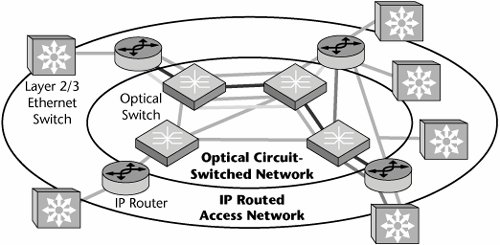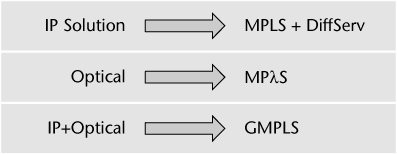The IP+Optical Control Plane
The optical network is becoming an ideal IP transport infrastructure in both core and metro networks due to its potentially unlimited bandwidth. However, service providers are experiencing great management costs and complexity with current architectures. As a result, we are moving toward a two-layer architecture that transports IP traffic directly over an optical network (see Figure 11.15). The challenges we face immediately include how to rapidly and effectively provision bandwidth and how to address protection and restoration.
Figure 11.15. The IP+optical control plane of the next-generation optical core

As Figure 11.16 shows, we are taking an evolutionary path to IP+optical. Today we still operate largely with IP running over ATM running over SHD/SONET running over DWDM. The next stage is to eliminate the ATM control plane and instead run IP and MPLS together over SDH/SONET over DWDM. As we begin to add more optical elements to the network, GMPLS will replace MPLS and run over a variation of SDH/SONET referred to as Thin SDH/SONET (meaning thin routes), which in turn will run over DWDM with optical switching. The final stage of the evolution is predicted to involved just two layers: IP and GMPLS running over DWDM and optical switches.
Figure 11.16. The IP+optical control plane evolution

IP+optical networks have two major considerations that are also two major benefits. First, they provide a platform for new service revenues. Intelligent optical networks support best-effort IP but also enable voice, video, and anything else to coexist, and they do so very economically. Second, IP+optical networks can reduce the amount of equipment and the number of protocol stacks. Intelligent optical switching reduces the footprint and the operation's complexity. GMPLS and the ASTN unify the protocols and the layers.
Standards efforts are working on optical management specifications, addressing the linking of IP services directly to the optical networks that carry data, allowing these IP+optical networks to take advantage of the routing intelligence now embedded in IP headers. As described in the following sections, the three main standards efforts are IETF (www.ietf.org) GMPLS, Optical Internetworking Forum (OIF; www.oiforum.com) UNI, and ITU (www.itu.int) ASON.
GMPLS
GMPLS extends MPLS to Layer 1, which allows a coupling of the IP and optical control planes. Routers, packet switches, and optical switches become aware of each other thanks to GMPLS. GMPLS supports fiber, lambda, and TDM switching. It enables dynamic optical networks, which means paths can be established through optical networks via signaling and routing protocols; this involves the use of an optical UNI that allows the edge to signal the core for more or different bandwidth.
The GMPLS control plane is an IP-based controller that employs IP protocols to operate the underlying optical network. It is a family of protocols that includes the following:
- Link Management Protocol (LMP) GMPLS introduces the concept of LMP, which accommodates neighbor identification and link verification, as well as shared-risk groups, fault isolation, and topology-aware networks.
- Signaling protocols GMPLS adds signaling, which enables us to signal into the network with a request that specifies the type of connection desired, change the path to use capacity previously not used, set up direct paths where needed and appropriate, and build in restoration. It uses signaling protocols for establishing links and restoration paths. GMPLS is implemented as a signaling protocol. When the route is calculated, GMPLS uses RSVPTraffic Engineering (RSVP-TE) or Constraint-Based Routed Label Distribution Protocol (CR-LDP) to set up the label-switched paths as it would with MPLS. However, GMPLS extends MPLS to control not only routers but also DWDM systems, ADMs, optical cross-connects, and optical switches.
- Routing protocols GMPLS uses routing protocols for selecting paths through the network. The routing protocols used include OSPF, IS-IS, and BGP.
GMPLS deals with several interfaces: packet switch capable (the only interface supported by MPLS); Layer 2 switch capable, which recognize frames and cells; TDM, which forward data based on the data's time slot; lambda switch capable, which work on individual wavelengths much like optical cross connects; and fiber switch capable, which work on individual or multiple fibers. GMPLS is a peer-to-peer network in which every participating label-switched router sees the entire network design.
The generic functions in the GMPLS control plane are mapped into different functional modules, including the resource management module, the connection module, the protection restoration module, and the main module. The resource management module is used for routing and wavelength assignment, for topology and resource discovery, and for support of QoS. It uses an OSPF-based routing protocol similar to that of GMPLS. The connection module is used for light path signaling and maintenance. In the GMPLS control plane, RSVP-TE or CR-LDP is used for the signaling. The protection restoration module is dedicated to fault monitoring and fast protection and restoration. The objective of the main module is to receive the incoming messages and work closely with other modules to process the requests.
In summary, GMPLS allows service providers to dynamically provision resources and provide the necessary redundancy for implementing various protection and restoration techniques. As Figure 11.17 shows, we're in the midst of an evolution. Those practicing pure IP solutions today look toward MPLS and DiffServ to administer QoS and manage their networks effectively. The early optical networks look toward MPLS as a control plane. In the future, the marriage of IP and optical naturally leads us to GMPLS, offering an end-to-end unified solution.
Figure 11.17. GMPLS, a unified end-to-end solution

UNI
The UNI for the GMPLS specification, as discussed earlier in this chapter, allows for neighbor discovery and channel assignment at the SDH/SONET level. The control interface can be an out-of-band Ethernet interface or an in-band command carried in the SDH/SONET overhead. The UNI specifies a way for a client, called a UNI client, to invoke transport network services with a UNI network, a device on another provider's network. Today, UNI is limited to three actions: connection creation, connection deletion, and connection status inquiry.
ASON
As discussed earlier in this chapter, ASON is based on a technology that enables automatic delivery of transport services. Specifically, an ASON network can deliver not only leased-lines connections but also other transport services, such as soft permanent and switched optical connections. In an ASON network, each network node should be equipped with a control plane. The control plane sets up and releases connections and can restore a connection in case of a failure.
ASON optical network elements will take over a number of tasks from the Telecommunications Management Network (TMN) architecture, including routing, restoration, service provisioning, admission control, and accounting. This requires the migration of OTN from a TMN-controlled network to a distributed approach: ASON. ASON is still in its early stages but will likely complement optical UNIs as well as GMPLS. The major features of ASON include fast provisioning, easy network operation, increased network reliability, scalability, and simple planning and design.
Although current optical networks offer enormous capacity compared to their IP counterparts, they are quite inflexible. Most of the limitations are a result of the fact that they are operated manually or via complex and slow network management systems. Drawbacks of existing optical networks include error-prone manual provisioning, long provisioning time, inefficient resource utilization, difficult interoperability between packet client networks and circuit-switched optical networks, complex network management, difficult interoperability between networks belonging to different operators, and lack of protection in mesh-type optical networks.
Network operators implementing the ASON control plane can expect increased revenue-generating capabilities, reduced operational cost, and increased return on capital. Additional benefits to operators include better resource utilization, reduction of manual intervention, simplification of network management systems, support for all-optical networks, and easier internetworking. The major benefits to customers include new services, reduction of service provisioning times, VPNs and closed user groups, bandwidth-on-demand services, provisioned bandwidth services, and wider SLA support capability.
An ASON network allows for three types of connections: permanent connections (established and controlled by a TMN), soft permanent connections (established by a TMN but controlled over the ASON plane), and switched connections (established and controlled by the ASON network).
Part I: Communications Fundamentals
Telecommunications Technology Fundamentals
- Telecommunications Technology Fundamentals
- Transmission Lines
- Types of Network Connections
- The Electromagnetic Spectrum and Bandwidth
- Analog and Digital Transmission
- Multiplexing
- Political and Regulatory Forces in Telecommunications
Traditional Transmission Media
Establishing Communications Channels
- Establishing Communications Channels
- Establishing Connections: Networking Modes and Switching Modes
- The PSTN Versus the Internet
The PSTN
- The PSTN
- The PSTN Infrastructure
- The Transport Network Infrastructure
- Signaling Systems
- Intelligent Networks
- SS7 and Next-Generation Networks
Part II: Data Networking and the Internet
Data Communications Basics
- Data Communications Basics
- The Evolution of Data Communications
- Data Flow
- The OSI Reference Model and the TCP/IP Reference Model
Local Area Networking
Wide Area Networking
The Internet and IP Infrastructures
- The Internet and IP Infrastructures
- Internet Basics
- Internet Addressing and Address Resolution
- The Organization of the Internet
- IP QoS
- Whats Next on the Internet
Part III: The New Generation of Networks
IP Services
Next-Generation Networks
- Next-Generation Networks
- The Broadband Evolution
- Multimedia Networking Requirements
- The Broadband Infrastructure
- Next-Generation Networks and Convergence
- The Next-Generation Network Infrastructure
Optical Networking
- Optical Networking
- Optical Networking Today and Tomorrow
- End-to-End Optical Networking
- The Optical Edge
- The Optical Core: Overlay Versus Peer-to-Peer Networking Models
- The IP+Optical Control Plane
- The Migration to Optical Networking
Broadband Access Alternatives
- Broadband Access Alternatives
- Drivers of Broadband Access
- DSL Technology
- Cable TV Networks
- Fiber Solutions
- Wireless Broadband
- Broadband PLT
- HANs
Part IV: Wireless Communications
Wireless Communications Basics
- Wireless Communications Basics
- A Brief History of Wireless Telecommunications
- Wireless Communications Regulations Issues
- Wireless Impairments
- Antennas
- Wireless Bandwidth
- Wireless Signal Modulation
- Spectrum Utilization
Wireless WANs
- Wireless WANs
- 1G: Analog Transmission
- 2G: Digital Cellular Radio
- 5G: Enhanced Data Services
- 3G: Moving Toward Broadband Wireless
- Beyond 3G
- 4G: Wireless Broadband
- 5G: Intelligent Technologies
WMANs, WLANs, and WPANs
Emerging Wireless Applications
- Emerging Wireless Applications
- The Handset Revolution
- Mobile IP
- The IP Multimedia Subsystem
- Mobile Gaming
- Mobile Video
- Mobile TV
- Mobile Content
Glossary
EAN: 2147483647
Pages: 160
